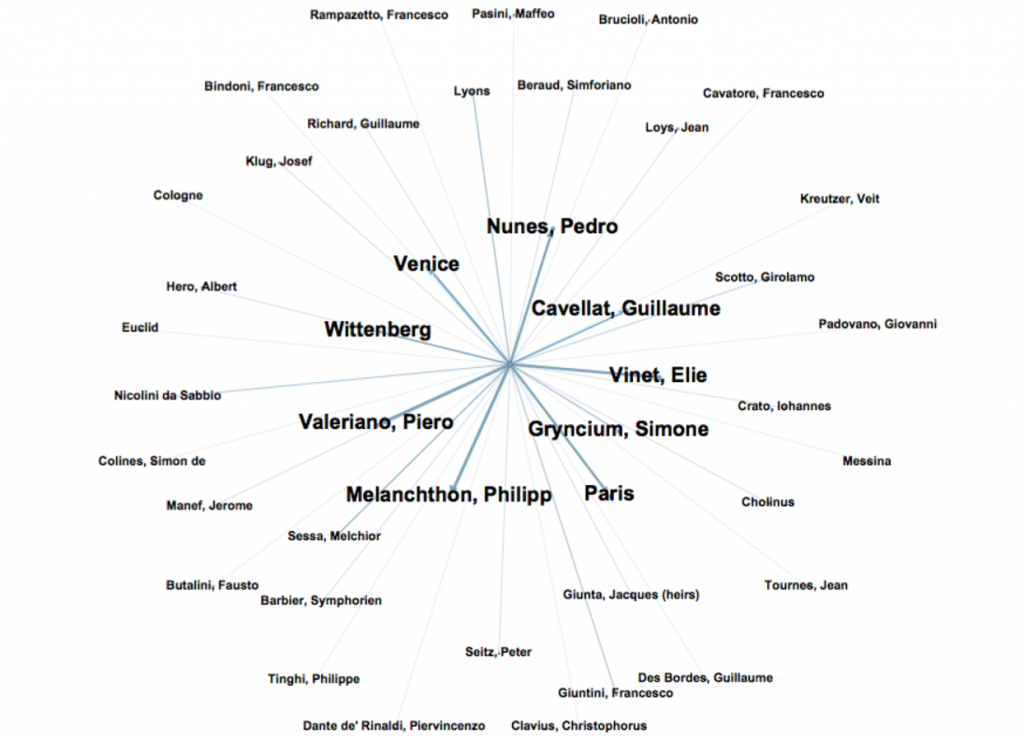Typically, for other genres, the works that must necessarily be considered as isotopes are ones that had a long circulation in European culture before Galileo’s lifetime. Early modern lists of books tend to express those volumes in terms of an idealized text with general properties that a contemporary audience was expected to know. Modern research has also correlated this minimization of detail about books in inventories with a decline in value for books overall after the first century of print made them readily available for consumers.1 For example, the transcriptions of the Archivio di Stato and Biblioteca Nazionale Centrale inventories of books offer details (if you can call them that!) about Galileo’s books that were inherited by his son and then by his daughter-in-law.
The works of astronomy in Galileo’s collection that fall into the isotope category are Giovanni Battista Carello’s Ephemerides of the seventeen-year span 1557-1575 (first ed. 1554), the tables that chart the coordinates of a celestial body at given intervals of time using Venice as a Meridian; Guidubaldo del Monte’s Planisphaeriorum (eds. 1579 in Italy and 1581 in Cologne); Kasper Peucer’s Hypotyposes (eds. 1568 in Strasbourg and 1573 in Cologne); an unspecficied edition of Giovanni Sacrobosco’s Sphaera mundi (discussed below); and three works by Ptolemy: the Almagest, Geographia, and Quadripartitum.
“Sfera del Sacrobosco. 8o”
An exemplary case for the astronomy category is Giovanni Sacrobosco’s Sphaera mundi, one of the pivotal medieval works for understanding cosmography and astronomy in the early modern period. Evidence confirms that Galileo owned a handsome quarto edition of the Jesuit Christoph Clavius’ commentary on Sacrobosco’s work, a valuable interpretation that dwarfed all preceding glosses in popularity once it appeared in Italy in 1570. The heading above is a transcription of the only evidence that Galileo owned a second copy of the work, printed in a smaller octavo edition, which Clavius’ work never was. Which led me to investigate what Sacrobosco’s Sphere looked like in this portable edition.
Before addressing the names looming large in the micro-network (below) of the 40 editions of the Sphere that appeared in octavo until Galileo’s death, I want to point out that only one edition acknowledges the work of Clavius in the title page information, and then only to claim its superiority.

Gephi rendering of the people and places mentioned on title pages of Giovanni Sacrobosco’s Sfera mundi printed in the ottavo (8o) format during Galileo’s lifetime.
There are many things to say about this fascinating look at one part of the print history of Sacrobosco’s work, but I would imagine that the one name that stands out to many of my colleagues in early modern studies is Philipp Melanchthon, collaborator with Martin Luther and a systematic theologian of early Protestantism, an author whose works were placed on the Index of Prohibited books by 1559. Since the author of this inventory of Galileo’s books was Vincenzo Viviani, Galileo’s student and caretaker at the end of his life, the rare lack of detail about this astronomy text can likely be attributed to his awareness that the book was valuable and dangerous to possess in Italy in the home of a man under house arrest after a trial for heresy.
Because Viviani’s list and Galileo’s correspondence are otherwise so specific about the works of astronomy that crossed Galileo’s path, we can move from these microhistories to an examination of the larger picture of astronomy as represented by the library.
Textual isotopes: Margherita Costa.
Edition isotopes: Francesco Berni.
[1] See Malcolm Walsby and Natasha Constantinidou, eds. Documenting the Early Modern Book World. Inventories and Catalogues in Manuscript and Print (London: BRILL, 2013).